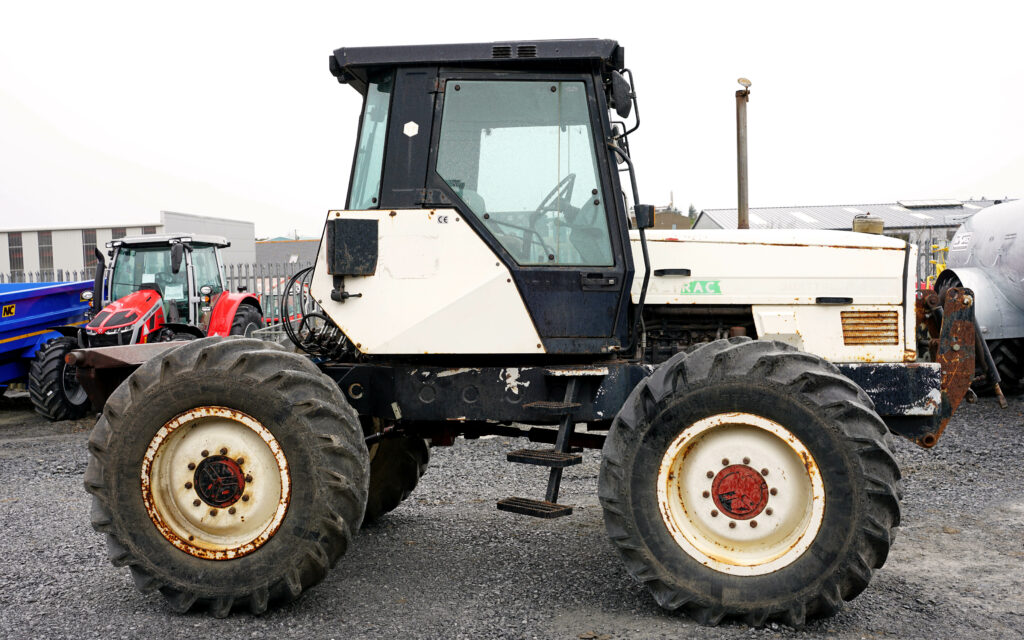The Massey Ferguson Quattrino 4120 is not a model that even many fans of the marque are familiar with, which is not to be judged too harshly, as no more than 20 were ever made, and it could have been even less.
It might even be asked whether it is a true Massey Ferguson tractor as the design and construction was undertaken by another company completely, Roux Industrie SA, of Montaun in southern France.
A real Massey
The question is valid, yet the tractors were created in conjunction with Massey Ferguson engineers at Beauvais, carried Massey Ferguson serial numbers, were sold through the company dealership network and, to begin with, carried the red and grey livery of Massey Ferguson tractors.
There can be no doubt that these are proper Massey Fergusons which, it is generally believed, were built to take on the MB Trac and other mid- or forward-cab machines such as the Deutz Fahr Intrac.

However, whereas the two German machines were originally conceived as genuine alternatives to the standard tractor format, the Quattrino is an adaption of a MF 3120 skid unit, which came with a 32-speed transmission and a six-cylinder Perkins engine.
The date of production of this particular example is thought to be 1991. The MF 3120 itself was introduced in 1990 with 111hp, this was increased to 120hp in 1992 before being discontinued completely in 1994.
Basic construction
Although the MB Trac had equal-sized wheels all round, the basic problem with the arrangement remains, and that is that it restricts the front wheel lock and hence the turning circle of the vehicle. Smaller wheels give greater manoeuvrability but less traction.
Massey Ferguson sought to overcome this fundamental problem by steering all four wheels together, which was not a new concept, but it did require a system to control the turning of the wheels.

The company opted for an early electronic system with several steering modes, enabling it, as far as is known, to be front-wheel-steer only, all-wheel-steer or crab-steer.
Unfortunately, the system is no longer working, yet MF dealer, Joe Whelan is confident that due to it being made up of simple wires and solenoids activating the steering rams, it can be figured out and put back into use without too much stress.
Quattrino chassis
If electronics had overcome the problem of steering, there was still the issue of fitting steering axles and providing a rear load platform.
This was addressed by inserting a meaty frame between the skid unit and two Carraro steering axles, raising the overall height and, with large equal-sized wheels, matching the traction potential of a County or Muir Hill.

To provide the rear platform, the transmission was split near the gearbox, which had to be specially constructed to accommodate a drop box to which the two drive shafts were attached.
The three-point linkage was then moved to the rear allowing a sprayer or fertiliser spreader to be mounted above the rear axle.
Altogether, the design has an air of a hastily conceived conversion rather than a carefully thought-out project, but any misgivings about its oddities are soon dispelled by the sound of the Perkins 6.354 straight six, which rumbles and roars like a big engine should.
History
The provenance of the tractor is somewhat hazy. It had, at some point, been converted to operate a trenching and cable laying implement and was probably used in France for that purpose.
From France it made its way across the channel to a UK collector who kept it for a couple of years before needing the room for another tractor, and this is where Joe Whelan found it and brought it home to Kilrush, Co. Clare, where the family owns the local Massey Ferguson dealership.

The tractor is showing only 1,813 hours on the clock, very possibly a genuine reading as there appears to be very little wear on the controls or seat.
It is painted white because after Massey Ferguson pulled the plug on the Quattrino project, Roux Industrie SA made a few more which were finished in this colour.
Joe Whelan is now thinking about changing it back to the more lively Massey Ferguson livery with a full and proper restorative respray.
The intention is to have it rejuvenated within the next few months and Agriland looks forward to visiting it again when all is finished and it is running as intended.

